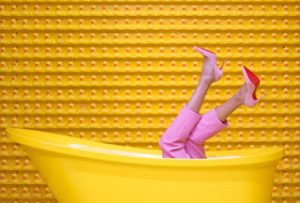Clothing Vocabulary: Adjectives, Dependent Prepositions, and Compound Nouns
Welcome to another “Engdrive” article! Today, we’re diving into the world of fashion vocabulary. Whether you’re a fashion enthusiast or simply want to expand your English vocabulary, understanding the language of clothing can be incredibly useful.

We’ll explore adjectives that describe clothes, dependent prepositions that add detail to our descriptions, and compound nouns that help us talk about specific items. Let’s get started!
Adjectives to Describe Clothes
Adjectives play a crucial role in expressing style, comfort, and suitability. Here are some common adjectives used to describe clothing, along with examples to illustrate their use:
- Casual: Refers to clothes that are informal and suitable for everyday wear.
Example: “She prefers wearing casual clothes like jeans and T-shirts, which are perfect for a relaxed day out.” - Formal: Used for clothes that are appropriate for official or important occasions.
Example: “For the office meeting, he wore a formal suit and tie to make a good impression.” - Trendy: Indicates clothes that are fashionable and in style.
Example: “This boutique sells trendy outfits that are very popular among young people.” - Vintage: Describes clothes that are old-fashioned but stylish, often from previous decades.
Example: “She has a passion for vintage clothing from the 70s, which adds a unique flair to her wardrobe.” - Comfortable: Emphasizes clothes that are easy and pleasant to wear.
Example: “I always choose comfortable shoes for long walks to avoid foot pain.” - Elegant: Refers to clothes that are stylish, sophisticated, and graceful.
Example: “She looked elegant in her evening gown at the gala.” - Tight-fitting: Describes clothes that fit closely to the body, highlighting the shape.
Example: “He chose a tight-fitting shirt that showed off his muscles.” - Loose: Refers to clothes that are not tight and allow for more movement and airflow.
Example: “During the summer, I prefer loose clothing to stay cool.” - Waterproof: Indicates clothes that can resist water, ideal for wet conditions.
Example: “A waterproof jacket is essential for hiking in rainy weather.” - Wrinkle-free: Describes clothes that do not easily crease, making them ideal for travel.
Example: “This shirt is wrinkle-free, so it’s perfect for traveling.”
Dependent Prepositions with Clothing Vocabulary
Dependent prepositions are small but mighty words that help clarify relationships between ideas. Here are some useful combinations related to fashion:
- Interested in: Shows a liking or concern for something.
Example: “She’s interested in fashion design and spends hours sketching new styles.” - Suitable for: Means appropriate or fitting for a particular purpose.
Example: “This dress is suitable for formal occasions, like weddings or gala dinners.” - Available in: Refers to the different options or variations something has.
Example: “The shoes are available in multiple colors, so you can choose your favorite.” - Known for: Used to describe a recognized characteristic or reputation.
Example: “That brand is known for its high-quality jeans and sustainable practices.” - Popular with: Indicates that something is liked or favored by a certain group.
Example: “This style of jacket is popular with teenagers, thanks to its modern design.”
Compound Nouns in the World of Fashion
Compound nouns are two words combined to create a single idea, and they’re common in the clothing industry. Here are some you might encounter:
- Raincoat: A coat that is resistant to rain, often made from waterproof material.
Example: “I need to buy a new raincoat for the upcoming rainy season.” - T-shirt: A casual top with short sleeves, usually made of cotton.
Example: “He wore a plain white T-shirt with jeans, a classic look.” - Sunglasses: Glasses tinted to protect the eyes from the sun.
Example: “Don’t forget to pack your sunglasses for the beach.” - Handbag: A small bag used by women to carry personal items.
Example: “She carried a small handbag to the party, just big enough for her essentials.” - Footwear: Refers to items worn on the feet, such as shoes, boots, or sandals.
Example: “The store specializes in outdoor footwear, perfect for hiking and trekking.” - Swimwear: Clothing designed for swimming, such as swimsuits or bikinis.
Example: “They have a wide selection of swimwear for summer, in all sizes and styles.” - Sweatshirt: A warm, long-sleeved top, often made of thick cotton material.
Example: “On cold days, I like wearing a cozy sweatshirt to keep warm.” - Eyeglasses: Corrective lenses set in a frame, worn to improve vision.
Example: “He put on his eyeglasses to read the menu.” - Underwear: Clothes worn beneath outer clothes, usually next to the skin.
Example: “I need to buy some new underwear.” - Nightwear: Clothing suitable for sleeping in, like pajamas or nightgowns.
Example: “Comfortable nightwear is important for a good night’s sleep.”
Conclusion
Fashion isn’t just about looking good—it’s also about communicating effectively. With these adjectives, dependent prepositions, and compound nouns, you’ll be better equipped to talk about clothes and style. Whether you’re discussing your latest shopping spree or describing your favorite outfit, this vocabulary will help you express yourself with flair. Stay tuned to “engdrive” for more language tips and tricks!
